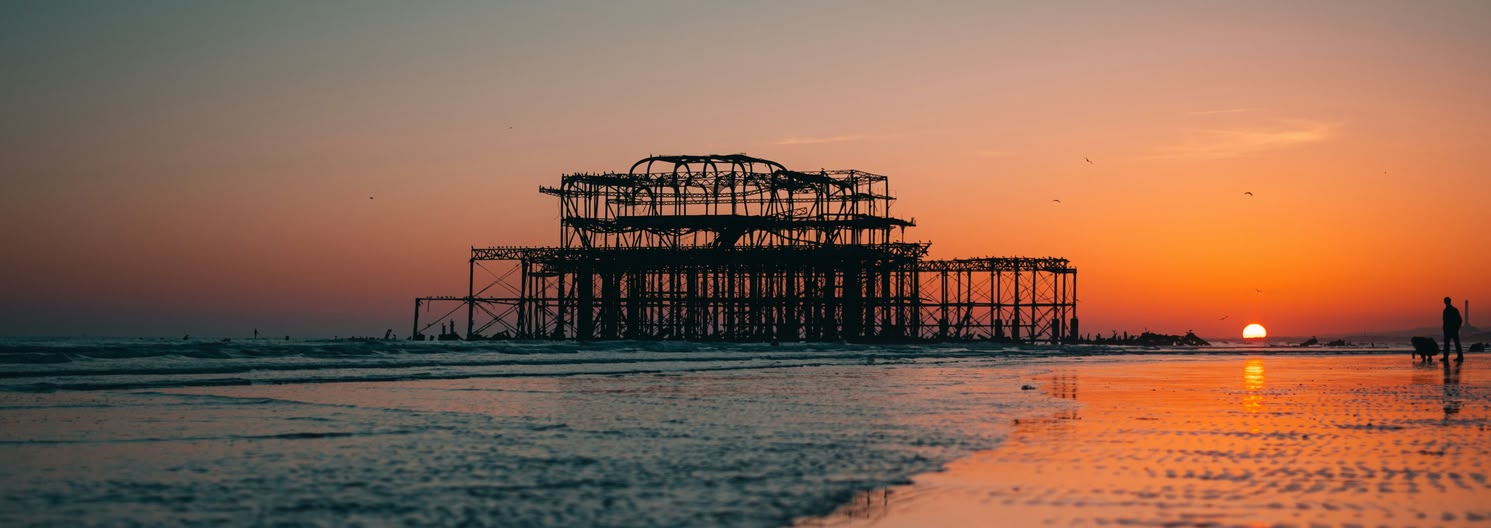Sunday to Friday until March 2026 for a private room or group stay with a minimum of 2 nights.
Brighton's West Pier
Discover a Fascinating History
Located directly in front of the West Beach Hotel, the iconic West Pier has long been a centerpiece of Brighton's seafront, evoking memories of a bygone era of British seaside culture. Though now a haunting skeletal structure, the pier's legacy continues to captivate both locals and visitors, telling a story of grandeur, decline, and enduring charm.

Piers in the UK: A Cultural Phenomenon
The development of piers was part of a wider cultural phenomenon in Victorian Britain. As railways made coastal towns more accessible, seaside piers became symbols of the growing leisure industry. These architectural marvels, like Blackpool's North Pier and Clevedon Pier, were places for promenading, enjoying fresh sea air, and indulging in entertainment. They combined elegance with innovation, transforming the British seaside experience. The West Pier was a key player in this cultural shift, providing Brighton with a stunning venue that blended entertainment with architectural grandeur.
A Victorian Marvel
The West Pier was opened to the public on October 6, 1866, designed by Eugenius Birch, one of the foremost pier architects of the Victorian age. Stretching 1,115 feet (340 meters) into the English Channel, its intricate ironwork, ornate kiosks, and gas lamps that lit up the structure quickly made it a hub of entertainment and leisure. Visitors flocked to enjoy concerts, theater performances, and leisurely strolls above the waves. At its height in the 1920s, over two million people visited the pier annually, cementing its place as a vibrant social hotspot.
Rise and Decline of a Cultural Landmark
Like many British piers, the West Pier was more than a structure-it symbolized the excitement and elegance of coastal life in the 19th and early 20th centuries. The pier underwent several expansions and improvements, including the addition of a concert hall in 1916 and a tea room in 1923. However, changing tourism trends and economic pressures began to erode its glory after World War II. By the 1960s, the pier faced significant maintenance issues and declining visitor numbers. The pier was officially closed to the public in 1975 for safety reasons, despite being awarded Grade I listed status by English Heritage in 1982 as a building of exceptional interest.
The West Pier's decline reached a heartbreaking climax in 2003 when two devastating fires destroyed much of its remaining structure. The first fire occurred on March 28, 2003, damaging the pavilion. A second, larger fire on May 11, 2003, destroyed the concert hall. The cause of the fires remains uncertain, but arson was suspected. These events effectively ended hopes for full restoration, leaving behind the skeletal remains that now stand as a reminder of the pier's former beauty.
The Pier Today: A Living Memory
Though the West Pier can no longer be walked upon, it remains a beloved part of Brighton's landscape. Its rusting frame, silhouetted against the sunset, has become an iconic image of the city, drawing photographers, artists, and curious visitors to the beach in front of the West Beach Hotel. The West Pier Trust, established in 1978, has worked tirelessly to preserve what remains and has salvaged artifacts for display in local museums, including the Brighton Museum & Art Gallery.
Legacy and Future Possibilities
Today, the West Pier stands as a poignant reminder of Brighton's rich history and a testament to the resilience of its culture. Though fully restoring the original pier has been deemed impractical, discussions about future projects are ongoing. The nearby British Airways i360 observation tower, opened in 2016 on the site of the pier's root end, offers a modern twist to the area and has been described as a "vertical pier."
As you stay at the West Beach Hotel, you are just steps away from one of the most evocative historical landmarks on the UK coast-a monument to both Brighton's past and its future possibilities. The pier's remaining structure continues to be a popular backdrop for photographs, particularly at sunrise and sunset when the ironwork is dramatically silhouetted against the sky.
Staying at the beachfront West Beach Hotel Brighton not only immerses you in the lively atmosphere of the city's famous seafront but also offers a unique connection to the enduring legacy of the West Pier. While its physical form may have weathered over time, its significance as a symbol of Brighton's identity and seaside heritage remains strong, giving guests a direct link to the city's rich cultural history.
